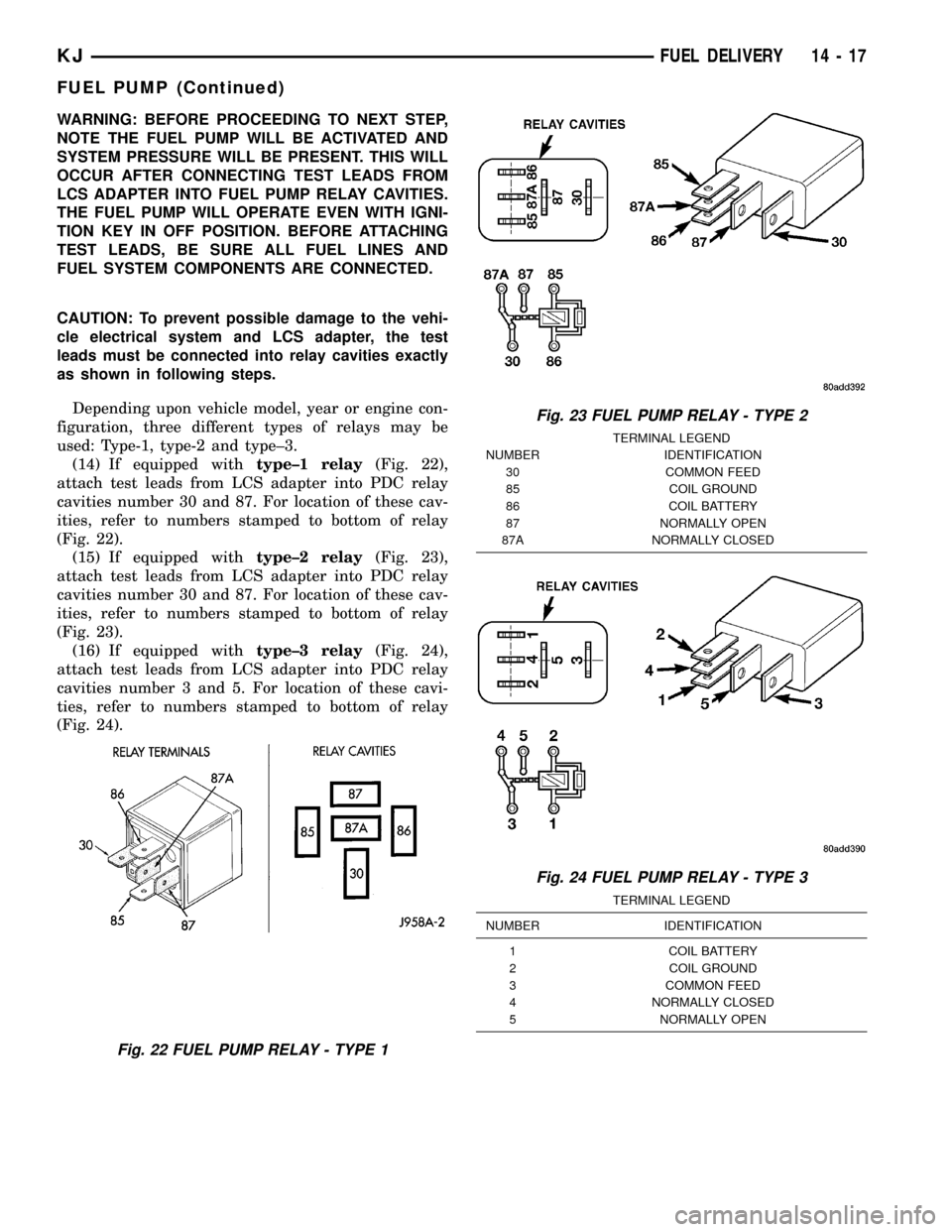2002 JEEP LIBERTY fuel type
[x] Cancel search: fuel typePage 1399 of 1803

WARNING: BEFORE PROCEEDING TO NEXT STEP,
NOTE THE FUEL PUMP WILL BE ACTIVATED AND
SYSTEM PRESSURE WILL BE PRESENT. THIS WILL
OCCUR AFTER CONNECTING TEST LEADS FROM
LCS ADAPTER INTO FUEL PUMP RELAY CAVITIES.
THE FUEL PUMP WILL OPERATE EVEN WITH IGNI-
TION KEY IN OFF POSITION. BEFORE ATTACHING
TEST LEADS, BE SURE ALL FUEL LINES AND
FUEL SYSTEM COMPONENTS ARE CONNECTED.
CAUTION: To prevent possible damage to the vehi-
cle electrical system and LCS adapter, the test
leads must be connected into relay cavities exactly
as shown in following steps.
Depending upon vehicle model, year or engine con-
figuration, three different types of relays may be
used: Type-1, type-2 and type±3.
(14) If equipped withtype±1 relay(Fig. 22),
attach test leads from LCS adapter into PDC relay
cavities number 30 and 87. For location of these cav-
ities, refer to numbers stamped to bottom of relay
(Fig. 22).
(15) If equipped withtype±2 relay(Fig. 23),
attach test leads from LCS adapter into PDC relay
cavities number 30 and 87. For location of these cav-
ities, refer to numbers stamped to bottom of relay
(Fig. 23).
(16) If equipped withtype±3 relay(Fig. 24),
attach test leads from LCS adapter into PDC relay
cavities number 3 and 5. For location of these cavi-
ties, refer to numbers stamped to bottom of relay
(Fig. 24).
Fig. 22 FUEL PUMP RELAY - TYPE 1
Fig. 23 FUEL PUMP RELAY - TYPE 2
TERMINAL LEGEND
NUMBER IDENTIFICATION
30 COMMON FEED
85 COIL GROUND
86 COIL BATTERY
87 NORMALLY OPEN
87A NORMALLY CLOSED
Fig. 24 FUEL PUMP RELAY - TYPE 3
TERMINAL LEGEND
NUMBER IDENTIFICATION
1 COIL BATTERY
2 COIL GROUND
3 COMMON FEED
4 NORMALLY CLOSED
5 NORMALLY OPEN
KJFUEL DELIVERY 14 - 17
FUEL PUMP (Continued)
Page 1423 of 1803

ronment that they operate in, that keep them from
being interchangeable.
Maintaining correct sensor temperature at all
times allows the system to enter into closed loop
operation sooner. Also, it allows the system to remain
in closed loop operation during periods of extended
idle.
In Closed Loop operation, the PCM monitors cer-
tain O2 sensor input(s) along with other inputs, and
adjusts the injector pulse width accordingly. During
Open Loop operation, the PCM ignores the O2 sensor
input. The PCM adjusts injector pulse width based
on preprogrammed (fixed) values and inputs from
other sensors.
Upstream Sensor - 2.4L Engine:The upstream
sensor (1/1) provides an input voltage to the PCM.
The input tells the PCM the oxygen content of the
exhaust gas. The PCM uses this information to fine
tune fuel delivery to maintain the correct oxygen con-
tent at the downstream oxygen sensor. The PCM will
change the air/fuel ratio until the upstream sensor
inputs a voltage that the PCM has determined will
make the downstream sensor output (oxygen content)
correct.
The upstream oxygen sensor also provides an input
to determine catalytic convertor efficiency.
Downstream Sensor - 2.4L Engine:The down-
stream oxygen sensor (1/2) is also used to determine
the correct air-fuel ratio. As the oxygen content
changes at the downstream sensor, the PCM calcu-
lates how much air-fuel ratio change is required. The
PCM then looks at the upstream oxygen sensor volt-
age and changes fuel delivery until the upstream
sensor voltage changes enough to correct the down-
stream sensor voltage (oxygen content).
The downstream oxygen sensor also provides an
input to determine catalytic convertor efficiency.
Upstream Sensors - 3.7L Engine:Two upstream
sensors are used (1/1 and 2/1). The 1/1 sensor is the
first sensor to receive exhaust gases from the #1 cyl-
inder. They provide an input voltage to the PCM. The
input tells the PCM the oxygen content of the
exhaust gas. The PCM uses this information to fine
tune fuel delivery to maintain the correct oxygen con-
tent at the downstream oxygen sensors. The PCM
will change the air/fuel ratio until the upstream sen-
sors input a voltage that the PCM has determined
will make the downstream sensors output (oxygen
content) correct.
The upstream oxygen sensors also provide an input
to determine mini-catalyst efficiency. Main catalytic
convertor efficiency is not calculated with this pack-
age.
Downstream Sensors - 3.7L Engine:Two down-
stream sensors are used (1/2 and 2/2). The down-
stream sensors are used to determine the correct air-fuel ratio. As the oxygen content changes at the
downstream sensor, the PCM calculates how much
air-fuel ratio change is required. The PCM then looks
at the upstream oxygen sensor voltage, and changes
fuel delivery until the upstream sensor voltage
changes enough to correct the downstream sensor
voltage (oxygen content).
The downstream oxygen sensors also provide an
input to determine mini-catalyst efficiency. Main cat-
alytic convertor efficiency is not calculated with this
package.
Engines equipped with either a downstream sen-
sor(s), or a post-catalytic sensor, will monitor cata-
lytic convertor efficiency. If efficiency is below
emission standards, the Malfunction Indicator Lamp
(MIL) will be illuminated and a Diagnostic Trouble
Code (DTC) will be set. Refer to Monitored Systems
in Emission Control Systems for additional informa-
tion.
REMOVAL
CAUTION: Never apply any type of grease to the
oxygen sensor electrical connector, or attempt any
soldering of the sensor wiring harness.
Refer to (Fig. 20), (Fig. 21) or (Fig. 22) for O2S
(oxygen sensor) location.
Fig. 20 OXYGEN SENSORS - 2.4L
1 - ELECTRICAL CONNECTORS
2 - UPSTREAM SENSOR (1/1)
3 - ELECTRICAL CONNECTORS
4 - DOWNSTREAM SENSOR (1/2)
KJFUEL INJECTION 14 - 41
OXYGEN SENSOR (Continued)
Page 1725 of 1803

Normal vehicle miles or engine misfire can cause a
catalyst to decay. This can increase vehicle emissions
and deteriorate engine performance, driveability and
fuel economy.
The catalyst monitor uses dual oxygen sensors
(O2S's) to monitor the efficiency of the converter. The
dual O2S's sensor strategy is based on the fact that
as a catalyst deteriorates, its oxygen storage capacity
and its efficiency are both reduced. By monitoring
the oxygen storage capacity of a catalyst, its effi-
ciency can be indirectly calculated. The upstream
O2S is used to detect the amount of oxygen in the
exhaust gas before the gas enters the catalytic con-
verter. The PCM calculates the A/F mixture from the
output of the O2S. A low voltage indicates high oxy-
gen content (lean mixture). A high voltage indicates a
low content of oxygen (rich mixture).
When the upstream O2S detects a lean condition,
there is an abundance of oxygen in the exhaust gas.
A functioning converter would store this oxygen so it
can use it for the oxidation of HC and CO. As the
converter absorbs the oxygen, there will be a lack of
oxygen downstream of the converter. The output of
the downstream O2S will indicate limited activity in
this condition.
As the converter loses the ability to store oxygen,
the condition can be detected from the behavior of
the downstream O2S. When the efficiency drops, no
chemical reaction takes place. This means the con-
centration of oxygen will be the same downstream as
upstream. The output voltage of the downstream
O2S copies the voltage of the upstream sensor. The
only difference is a time lag (seen by the PCM)
between the switching of the O2S's.
To monitor the system, the number of lean-to-rich
switches of upstream and downstream O2S's is
counted. The ratio of downstream switches to
upstream switches is used to determine whether the
catalyst is operating properly. An effective catalyst
will have fewer downstream switches than it has
upstream switches i.e., a ratio closer to zero. For a
totally ineffective catalyst, this ratio will be one-to-
one, indicating that no oxidation occurs in the device.
The system must be monitored so that when cata-
lyst efficiency deteriorates and exhaust emissions
increase to over the legal limit, the MIL will be illu-
minated.
DESCRIPTION - TRIP DEFINITION
The term ªTripº has different meanings depending
on what the circumstances are. If the MIL (Malfunc-
tion Indicator Lamp) is OFF, a Trip is defined as
when the Oxygen Sensor Monitor and the Catalyst
Monitor have been completed in the same drive cycle.
When any Emission DTC is set, the MIL on the
dash is turned ON. When the MIL is ON, it takes 3good trips to turn the MIL OFF. In this case, it
depends on what type of DTC is set to know what a
ªTripº is.
For the Fuel Monitor or Mis-Fire Monitor (contin-
uous monitor), the vehicle must be operated in the
ªSimilar Condition Windowº for a specified amount of
time to be considered a Good Trip.
If a Non-Contiuous OBDII Monitor fails twice in a
row and turns ON the MIL, re-running that monitor
which previously failed, on the next start-up and
passing the monitor, is considered to be a Good Trip.
These will include the following:
²Oxygen Sensor
²Catalyst Monitor
²Purge Flow Monitor
²Leak Detection Pump Monitor (if equipped)
²EGR Monitor (if equipped)
²Oxygen Sensor Heater Monitor
If any other Emission DTC is set (not an OBDII
Monitor), a Good Trip is considered to be when the
Oxygen Sensor Monitor and Catalyst Monitor have
been completed; or 2 Minutes of engine run time if
the Oxygen Sensor Monitor or Catalyst Monitor have
been stopped from running.
It can take up to 2 Failures in a row to turn on the
MIL. After the MIL is ON, it takes 3 Good Trips to
turn the MIL OFF. After the MIL is OFF, the PCM
will self-erase the DTC after 40 Warm-up cycles. A
Warm-up cycle is counted when the ECT (Engine
Coolant Temperature Sensor) has crossed 160ÉF and
has risen by at least 40ÉF since the engine has been
started.
DESCRIPTION - COMPONENT MONITORS
There are several components that will affect vehi-
cle emissions if they malfunction. If one of these com-
ponents malfunctions the Malfunction Indicator
Lamp (MIL) will illuminate.
Some of the component monitors are checking for
proper operation of the part. Electrically operated
components now have input (rationality) and output
(functionality) checks. Previously, a component like
the Throttle Position sensor (TPS) was checked by
the PCM for an open or shorted circuit. If one of
these conditions occurred, a DTC was set. Now there
is a check to ensure that the component is working.
This is done by watching for a TPS indication of a
greater or lesser throttle opening than MAP and
engine rpm indicate. In the case of the TPS, if engine
vacuum is high and engine rpm is 1600 or greater
and the TPS indicates a large throttle opening, a
DTC will be set. The same applies to low vacuum if
the TPS indicates a small throttle opening.
All open/short circuit checks or any component that
has an associated limp in will set a fault after 1 trip
with the malfunction present. Components without
KJEMISSIONS CONTROL 25 - 19
EMISSIONS CONTROL (Continued)
Page 1749 of 1803

FLUID DRAIN AND FILL - STANDARD
PROCEDURE.................21-208,21-246
FLUID FILL/CHECK LOCATIONS -
DESCRIPTION.........................0-4
FLUID INDICATOR - DESCRIPTION,
WASHER...........................8J-35
FLUID INDICATOR - DIAGNOSIS AND
TESTING, WASHER...................8J-36
FLUID INDICATOR - OPERATION,
WASHER...........................8J-36
FLUID LEAK - DIAGNOSIS AND TESTING,
CONVERTER HOUSING................21-80
FLUID LEVEL - DIAGNOSIS AND
TESTING, EFFECTS OF INCORRECT......21-125
FLUID LEVEL - STANDARD
PROCEDURES, MASTER CYLINDER.......5-26
FLUID LEVEL CHECK - STANDARD
PROCEDURE.......................21-126
FLUID LEVEL SWITCH - DESCRIPTION,
WASHER...........................8R-17
FLUID LEVEL SWITCH - INSTALLATION,
WASHER...........................8R-18
FLUID LEVEL SWITCH - OPERATION,
WASHER...........................8R-17
FLUID LEVEL SWITCH - REMOVAL,
WASHER...........................8R-17
FLUID RESERVOIR - INSTALLATION.......5-26
FLUID RESERVOIR - REMOVAL..........5-26
FLUID, SPECIFICATIONS - BRAKE.........5-27
FLUID TYPES - DESCRIPTION.............0-1
FLUSH - SPECIFICATIONS, GAP........23-116
FLUSHING - STANDARD PROCEDURE,
COOLING SYSTEM - REVERSE...........7-12
FLYWHEEL - DESCRIPTION...............6-7
FLYWHEEL - DIAGNOSIS AND TESTING.....6-8
FLYWHEEL - OPERATION................6-7
FOG LAMP BULB - INSTALLATION,
FRONT.............................8L-22
FOG LAMP BULB - REMOVAL, FRONT....8L-21
FOG LAMP INDICATOR - DESCRIPTION,
FRONT.............................8J-19
FOG LAMP INDICATOR - DESCRIPTION,
REAR..............................8J-27
FOG LAMP INDICATOR - OPERATION,
FRONT.............................8J-19
FOG LAMP INDICATOR - OPERATION,
REAR..............................8J-27
FOG LAMP RELAY - DESCRIPTION,
FRONT.............................8L-22
FOG LAMP RELAY - DESCRIPTION, REAR . 8L-56
FOG LAMP RELAY - DIAGNOSIS AND
TESTING, FRONT.....................8L-23
FOG LAMP RELAY - DIAGNOSIS AND
TESTING, REAR......................8L-57
FOG LAMP RELAY - INSTALLATION,
FRONT.............................8L-24
FOG LAMP RELAY - INSTALLATION,
REAR..............................8L-58
FOG LAMP RELAY - OPERATION, FRONT . . 8L-22
FOG LAMP RELAY - OPERATION, REAR . . . 8L-57
FOG LAMP RELAY - REMOVAL, FRONT . . . 8L-24
FOG LAMP RELAY - REMOVAL, REAR....8L-58
FOG LAMP UNIT - ADJUSTMENT, FRONT . . 8L-25
FOG LAMP UNIT - INSTALLATION,
FRONT.............................8L-25
FOG LAMP UNIT - REMOVAL, FRONT.....8L-25
FOLDING REAR SEAT BACK LATCH /
LOCK - INSTALLATION
...............23-170
FOLDING REAR SEAT BACK LATCH /
LOCK - REMOVAL
...................23-170
FOUR LOW MODE INDICATOR -
DESCRIPTION
.......................8J-29
FOUR LOW MODE INDICATOR -
OPERATION
.........................8J-30
FRAME - REAR - INSTALLATION, SEAT
BACK
.............................23-171
FRAME - REAR - REMOVAL, SEAT BACK
. 23-171
FRAME DIMENSIONS - SPECIFICATIONS
. . . 13-3
FRONT - DESCRIPTION
..................2-7
FRONT - INSTALLATION, CRANKSHAFT
OIL SEAL
............................9-47
FRONT - INSTALLATION, PROPELLER
SHAFT
...............................3-6
FRONT - INSTALLATION, SEAT
.........23-165
FRONT - INSTALLATION, SEAT BACK
....23-166
FRONT - INSTALLATION, SEAT BACK
COVER
............................23-167FRONT - INSTALLATION, SEAT BACK
CUSHION..........................23-167
FRONT - INSTALLATION, SEAT BACK
RECLINER.........................23-166
FRONT - INSTALLATION, SEAT CUSHION . 23-167
FRONT - INSTALLATION, SEAT CUSHION
COVER............................23-167
FRONT - REMOVAL, CRANKSHAFT OIL
SEAL...............................9-46
FRONT - REMOVAL, PROPELLER SHAFT....3-6
FRONT - REMOVAL, SEAT.............23-165
FRONT - REMOVAL, SEAT BACK........23-166
FRONT - REMOVAL, SEAT BACK COVER . . 23-166
FRONT - REMOVAL, SEAT BACK
CUSHION..........................23-167
FRONT - REMOVAL, SEAT BACK
RECLINER.........................23-166
FRONT - REMOVAL, SEAT CUSHION.....23-167
FRONT - REMOVAL, SEAT CUSHION
COVER............................23-167
FRONT - WARNING.....................2-7
FRONT AXLE - 186FIA - ADJUSTMENTS....3-25
FRONT AXLE - 186FIA - DESCRIPTION.....3-19
FRONT AXLE - 186FIA - INSTALLATION....3-24
FRONT AXLE - 186FIA - OPERATION......3-19
FRONT AXLE - 186FIA - REMOVAL........3-24
FRONT AXLE - SPECIFICATIONS..........3-33
FRONT AXLE, SPECIAL TOOLS...........3-34
FRONT BRAKE HOSE - INSTALLATION.......5-10
FRONT BRAKE PADS - INSTALLATION.....5-11
FRONT BRAKE PADS - REMOVAL.........5-11
FRONT CHECK VALVE - DESCRIPTION.....8R-8
FRONT CHECK VALVE - INSTALLATION....8R-9
FRONT CHECK VALVE - OPERATION.......8R-9
FRONT CHECK VALVE - REMOVAL........8R-9
FRONT DOOR OUTER BELT MOLDING -
INSTALLATION......................23-186
FRONT DOOR OUTER BELT MOLDING -
REMOVAL.........................23-186
FRONT FASCIA - INSTALLATION..........13-2
FRONT FASCIA - REMOVAL..............13-1
FRONT FENDER - INSTALLATION.......23-141
FRONT FENDER - REMOVAL...........23-141
FRONT FOG LAMP BULB -
INSTALLATION.......................8L-22
FRONT FOG LAMP BULB - REMOVAL.....8L-21
FRONT FOG LAMP INDICATOR -
DESCRIPTION.......................8J-19
FRONT FOG LAMP INDICATOR -
OPERATION.........................8J-19
FRONT FOG LAMP RELAY -
DESCRIPTION.......................8L-22
FRONT FOG LAMP RELAY - DIAGNOSIS
AND TESTING.......................8L-23
FRONT FOG LAMP RELAY -
INSTALLATION.......................8L-24
FRONT FOG LAMP RELAY - OPERATION . . 8L-22
FRONT FOG LAMP RELAY - REMOVAL....8L-24
FRONT FOG LAMP UNIT - ADJUSTMENT . . 8L-25
FRONT FOG LAMP UNIT - INSTALLATION . . 8L-25
FRONT FOG LAMP UNIT - REMOVAL.....8L-25
FRONT HOSE - REMOVAL................5-9
FRONT IMPACT SENSOR - DESCRIPTION . 8O-21
FRONT IMPACT SENSOR -
INSTALLATION......................8O-22
FRONT IMPACT SENSOR - OPERATION . . . 8O-21
FRONT IMPACT SENSOR - REMOVAL....8O-22
FRONT LAMP BULB - INSTALLATION.....8L-27
FRONT LAMP BULB - REMOVAL.........8L-26
FRONT LAMP UNIT - INSTALLATION.....8L-28
FRONT LAMP UNIT - REMOVAL.........8L-27
FRONT MOUNT - INSTALLATION..........9-57
FRONT MOUNT - REMOVAL.............9-56
FRONT OUTPUT SHAFT SEAL -
INSTALLATION................21-208,21-246
FRONT OUTPUT SHAFT SEAL -
REMOVAL...................21-208,21-246
FRONT POSITION LAMP BULB -
INSTALLATION.......................8L-28
FRONT POSITION LAMP BULB -
REMOVAL
..........................8L-28
FRONT SEAL - INSTALLATION, OIL
PUMP
............................21-152
FRONT SEAL - REMOVAL, OIL PUMP
....21-152
FRONT SEAT BELT & RETRACTOR -
INSTALLATION
......................8O-24
FRONT SEAT BELT & RETRACTOR -
REMOVAL
..........................8O-23FRONT SEAT BELT BUCKLE -
INSTALLATION......................8O-26
FRONT SEAT BELT BUCKLE - REMOVAL . . 8O-25
FRONT SKID PLATE - INSTALLATION......13-6
FRONT SKID PLATE - REMOVAL..........13-6
FRONT SUSPENSION, SPECIAL TOOLS.....2-8
FRONT TOW HOOK - INSTALLATION......13-8
FRONT TOW HOOK - REMOVAL..........13-8
FRONT WASHER HOSES/TUBES -
DESCRIPTION.......................8R-10
FRONT WASHER HOSES/TUBES -
OPERATION.........................8R-10
FRONT WASHER NOZZLE -
DESCRIPTION.......................8R-11
FRONT WASHER NOZZLE -
INSTALLATION......................8R-11
FRONT WASHER NOZZLE - OPERATION . . . 8R-11
FRONT WASHER NOZZLE - REMOVAL....8R-11
FRONT WHEEL OPENING FLARE
MOLDINGS - INSTALLATION...........23-145
FRONT WHEEL OPENING FLARE
MOLDINGS - REMOVAL..............23-145
FRONT WHEEL SPEED SENSOR -
INSTALLATION........................5-34
FRONT WHEEL SPEED SENSOR -
REMOVAL...........................5-34
FRONT WHEELHOUSE SPLASH SHIELD -
INSTALLATION......................23-143
FRONT WHEELHOUSE SPLASH SHIELD -
REMOVAL.........................23-143
FRONT WIPER & WASHER SYSTEM -
CLEANING...........................8R-7
FRONT WIPER & WASHER SYSTEM -
DIAGNOSIS AND TESTING..............8R-6
FRONT WIPER & WASHER SYSTEM -
INSPECTION.........................8R-7
FRONT WIPER ARM - DESCRIPTION.....8R-12
FRONT WIPER ARM - INSTALLATION.....8R-13
FRONT WIPER ARM - OPERATION.......8R-12
FRONT WIPER ARM - REMOVAL........8R-12
FRONT WIPER BLADE - DESCRIPTION....8R-13
FRONT WIPER BLADE - INSTALLATION . . . 8R-14
FRONT WIPER BLADE - OPERATION.....8R-14
FRONT WIPER BLADE - REMOVAL.......8R-14
FRONT WIPER MODULE - DESCRIPTION . . 8R-15
FRONT WIPER MODULE - INSTALLATION . 8R-16
FRONT WIPER MODULE - OPERATION....8R-15
FRONT WIPER MODULE - REMOVAL.....8R-16
FRONT WIPERS/WASHERS -
DESCRIPTION........................8R-2
FRONT WIPERS/WASHERS - OPERATION . . 8R-4
FRONT WIPER/WASHER SWITCH -
DESCRIPTION.......................8R-16
FRONT WIPER/WASHER SWITCH -
OPERATION.........................8R-16
FUEL DELIVERY - DESCRIPTION..........14-2
FUEL DELIVERY - OPERATION...........14-3
FUEL FILL DOOR/HOUSING -
INSTALLATION......................23-141
FUEL FILL DOOR/HOUSING - REMOVAL . . 23-141
FUEL FILLER CAP - DESCRIPTION.......25-27
FUEL FILLER CAP - OPERATION.........25-27
FUEL FILTER - DESCRIPTION............14-7
FUEL FILTER - INSTALLATION............14-8
FUEL FILTER - REMOVAL...............14-7
FUEL GAUGE - DESCRIPTION...........8J-19
FUEL GAUGE - OPERATION.............8J-20
FUEL INDICATOR - DESCRIPTION, LOW
. . . 8J-22
FUEL INDICATOR - OPERATION, LOW
.....8J-22
FUEL INJECTION - DESCRIPTION
........14-29
FUEL INJECTOR - DESCRIPTION
.........14-33
FUEL INJECTOR - DIAGNOSIS AND
TESTING
...........................14-33
FUEL INJECTOR - OPERATION
..........14-33
FUEL LEVEL SENDING UNIT -
DIAGNOSIS AND TESTING
..............14-9
FUEL LEVEL SENDING UNIT / SENSOR -
DESCRIPTION
........................14-9
FUEL LEVEL SENDING UNIT / SENSOR -
INSTALLATION
.......................14-10
FUEL LEVEL SENDING UNIT / SENSOR -
OPERATION
..........................14-9
FUEL LEVEL SENDING UNIT / SENSOR -
REMOVAL
...........................14-9
FUEL LINES - DESCRIPTION
............14-10
FUEL PRESSURE LEAK DOWN TEST -
DIAGNOSIS AND TESTING
..............14-3
10 INDEXKJ
Description Group-Page Description Group-Page Description Group-Page